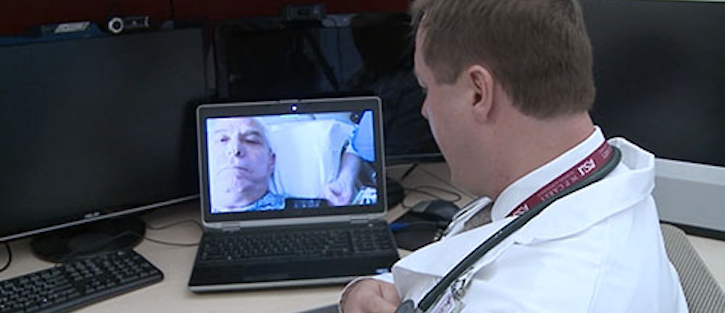- Politics
- Diversity, equity and inclusion
- Financial Decision Making
- Telehealth
- Patient Experience
- Leadership
- Point of Care Tools
- Product Solutions
- Management
- Technology
- Healthcare Transformation
- Data + Technology
- Safer Hospitals
- Business
- Providers in Practice
- Mergers and Acquisitions
- AI & Data Analytics
- Cybersecurity
- Interoperability & EHRs
- Medical Devices
- Pop Health Tech
- Precision Medicine
- Virtual Care
- Health equity
Telehealth Rehab Program for Patients with COPD Reduces 30-day Readmissions
The telehealth program reduced 30-day readmissions, which could substantially reduce healthcare costs for patients with COPD.

Photo/Thumb have been modified. Courtesy of Cronkite News.
Video telehealth pulmonary rehabilitation interventions can reduce 30-day all-cause readmission rates following hospitalizations for chronic obstructive pulmonary disease (COPD) exacerbation, according to a study published in the American Journal of Respiratory and Critical Care Medicine.
Surya P. Bhatt, M.D., associate professor in the division of pulmonary, allergy and critical care medicine at the University of Alabama at Birmingham, and his research team found that compared with COPD patients who did not participate in the telehealth program, the 30-day hospital readmission rate decreased from 18.1% to 6.2%.
The team enrolled patients hospitalized for an exacerbation in a video telehealth pulmonary rehabilitation program at a single quaternary care academic hospital from March 2015 and on.
Participants were identified using a daily hospital census and were selected regardless of the severity of their COPD, except those with unstable arrhythmias, congestive heart failure with a left ventricular ejection fraction less than 25% or other comorbidities.
There were 80 patients enrolled in the program and 160 patients who were not exposed to it.
The 80 patients were provided a smartphone with video capabilities.
The intervention consisted of a standardized regimen of 36 exercise sessions over 12 weeks.
An exercise physiologist made exercise prescriptions after an initial outpatient exercise assessment. Exercises were tailored per baseline functional level and impairment prior to exacerbation.
The regimen included a combination of stretching and breathing exercises — pursed lips breathing, paced breathing and diaphragmatic muscle strength training — followed by 20 minutes of aerobic exercises using a portable foot pedaller that was provided so patients could achieve a heart rate between 60 and 80% of the maximum recorded on the baseline six-minute walk test.
The program also included resistance training and basic yoga exercises.
Videoconference calls also included educational sessions on smoking cessation, appropriate inhaler techniques, disease education, monitoring and reporting exacerbations and self-efficacy.
Following the intervention, the researchers saw that the 30-day all-cause readmission rate was significantly lower for the patients that completed the program, compared with those who did not.
“By reducing COPD readmissions, this intervention has the potential to substantially reduce healthcare costs,” Bhatt said.
Readmissions due to acute exacerbation of COPD were also lower with the telehealth group (3.8%) than in the unexposed group (11.9%) — which could lead to a decrease in respiratory morbidity — and the time it took for the first readmission was longer for individuals who used the program (265 days) than in those who did not (211 days).
“The video telehealth pulmonary rehabilitation program, by overcoming many barriers to early initiation of pulmonary rehabilitation, can expand access to pulmonary rehabilitation, especially for patients who live in rural areas,” Bhatt said.
Bhatt added that this intervention could be easily applicable with other chronic lung diseases, but the results need confirmation in a randomized clinical trial.
Get the best insights in healthcare analytics directly to your inbox.
Related
Vascular Surgery Patients Satisfied with Post-Surgical Telemonitoring
Patients, Clinicians Satisfied with Telehealth for Follow-Up Care
Podcast: Adoption of Healthcare Tech in the Age of COVID-19 with Dr Kaveh Safavi
June 22nd 2021Kaveh Safavi, MD, JD, global health lead of Accenture Health, discusses how the pandemic influenced the speed at which healthcare organizations adopted new technologies and how this adoption is impacting patient care.
